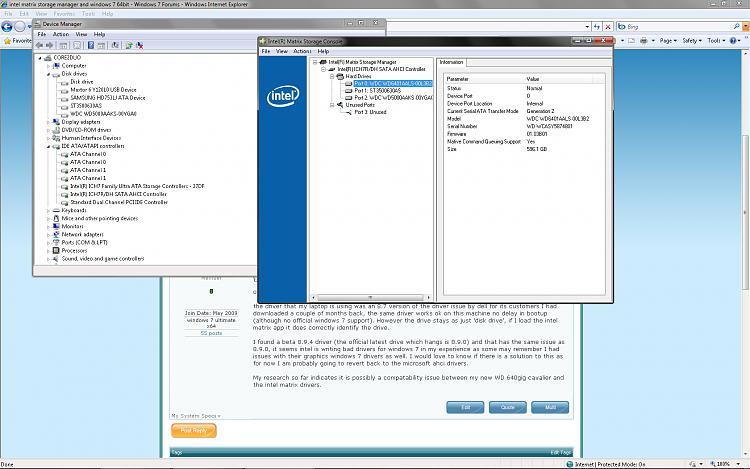Ahci Driver Windows 7 64 Bit

This article needs additional citations for. Unsourced material may be challenged and removed.
I have an old HP DC7800 (it actually says DC7900 on the box, but several firmwares says it is a dc7800 for some odd reason.) convertible minitower that I use at home, running Windows 7.
Find sources: – ( August 2012) () AHCI Advanced Host Controller Interface Website The Advanced Host Controller Interface ( AHCI) is a technical standard defined by that specifies the operation of (SATA) in a non-implementation-specific manner in its. The specification describes a system memory structure for computer hardware vendors to exchange data between host system and attached. AHCI gives software developers and hardware designers a standard method for detecting, configuring, and programming SATA/AHCI adapters. AHCI is separate from the SATA 3 Gbit/s standard, although it exposes SATA's advanced capabilities (such as and ) such that host systems can utilize them. As of March 2014, the current version of the specification is 1.3.1.
Contents • • • • • • • Operating Modes [ ] Many SATA controllers offer selectable modes of operation: legacy emulation (more commonly called IDE Mode), standard AHCI mode (also known as Native Mode), or vendor-specific (which generally enables AHCI in order to take advantage of its capabilities). Intel recommends choosing RAID mode on their (which also enables AHCI) rather than AHCI/SATA mode for maximum flexibility. Legacy mode is a software mechanism intended to allow the SATA controller to run in legacy operating systems which are not SATA-aware or where a driver does not exist to make the operating system SATA-aware. When a SATA controller is configured to operate in Legacy Mode, the number of storage devices per controller is usually limited to four (two IDE channels, primary and secondary, with up to two devices per channel), compared to the maximum of 32 devices/ports when configured in AHCI mode. Operating System Support [ ] AHCI is supported out of the box on and later, -based operating systems (since version 2.6.19 of the ), (since version 4.1), (since version 4.0), (since version 8.0),, (since version 2.1), and (since version 8/07). Based its AHCI implementation on OpenBSD's and added extended features such as port multiplier support. Older versions of operating systems require hardware-specific drivers in order to support AHCI.
And older do not provide AHCI support out of the box. System Drive Boot Issues [ ] Some operating systems, notably,,, and, do not configure themselves to load the AHCI driver upon boot if the SATA controller was not in AHCI mode at the time the operating system was installed.
Minimum System Requirements OS: Windows XP/Vista/7 Processor: INTEL 2.4 GHz Dual Core RAM: 1 GB Video Memory: 128 MB Video Card: NVIDIA GeForce 9100 or ATI Radeon X300 Series Sound Card: DirectX Compatible DirectX: 9.0c Hard Drive: 5 GB free Recommended System Requirements OS: Windows XP/Vista/7 Processor: INTEL 3.0 GHz Dual Core RAM: 2 GB Video Memory: 256 MB Video Card: NVIDIA GeForce 6800 GS or ATI Radeon 9800 Pro Sound Card: DirectX Compatible DirectX: 9.0c Hard Drive: 5 GB free Battlefield 2 Download Free PC Game Click on the below button to start Battlefield 2 Download Free. We have provided direct link full setup of the game. It is full and complete game. Battlefield 2 pc crack free download. Just download and start playing it.
Although this is an easily rectifiable condition, it remains an ongoing issue with the AHCI standard. The most prevalent symptom for an operating system (or systems) that are installed in IDE mode (in some BIOS firmware implementations otherwise called 'Combined IDE mode'), is that the system drive typically fails to boot, with an ensuing error message, if the SATA controller (in BIOS) is inadvertently switched to AHCI mode after OS installation.
In Microsoft Windows the symptom is a boot loop which begins with a Blue Screen error, if not rectified - and through no fault of the Windows OS. Technically speaking, this is an implementation bug with AHCI that can be avoided, but it has not been fixed yet. As an interim resolution, Intel recommends changing the drive controller to AHCI or RAID before installing an operating system. (It may also be necessary to load chipset-specific AHCI or RAID drivers at installation time, for example from a USB flash drive).
On Windows Vista and Windows 7, this can be fixed by configuring the msahci device driver to start at boot time (rather than on-demand). Setting non-AHCI mode (i.e. IDE or Combined mode) in the will allow the user to boot into Windows, and thereby the required change can be performed. Consequently, the user then has the option of continuing to use the system in Combined mode or switching to AHCI mode. With Windows 10, this can be fixed by forcing the correct drivers to reload during.

In Windows 8, Windows 8.1 and, the name of the controller has changed from msahci to storahci, and the procedures to upgrade to the new controller is similar to that of Windows 7. On Windows 8, 8.1 and Windows Server 2012, changing from SATA mode to AHCI mode without first updating the registry will make the boot drive inaccessible (i.e. Resulting in a recurring boot loop, which begins with a Blue Screen error). A similar problem can occur on Linux systems if the AHCI driver is compiled as a rather than built into the, as it may not be included in the (initial RAM disk) created when the controller is configured to run in Legacy Mode. The solution is either to build a new initrd containing the AHCI module, or to build the AHCI driver into the kernel image. Power management [ ] Power management is handled by the (ALPM) protocol.